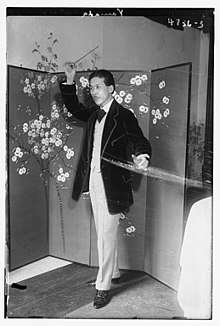Kosaku Yamada
| Kosaku Yamada | |
|---|---|
 Kosaku Yamada in Manhattan in 1918 | |
| Born |
June 9, 1886 Tokyo, Japan |
| Died |
December 29, 1965 (aged 79) Tokyo, Japan |
| Cause of death | Heart attack |
| Education | Tokyo Music School |
| Relatives | elder sister:Tuneko Gauntlett, uncle:George Edward Luckman Gauntlett |
Kosaku Yamada (山田 耕筰 Yamada Kōsaku, 9 June 1886 – 29 December 1965) was a Japanese composer and conductor.[1][2]
Name
In many Western reference books his name is given as Kôsçak Yamada. During his music study in the Imperial German capital of Berlin from 1910 to 1913 he hated the times when people laughed at him because his "normal" transliteration of his first name "Kosaku" sounded like the Italian "cosa" meaning "what" or "thing" + the German "Kuh" meaning "cow"; which resulted in his choosing a somewhat fanciful transliteration of Kôsçak Yamada ever since.
Biography
Yamada was born in Tokyo on 9 June 1886.[1]
After studying at the Tokyo Music School, he left Japan for Germany where he enrolled in the Berlin Hochschule and learnt composition under Max Bruch and Karl Leopold Wolf and piano under Carl August Heymann-Rheineck, before returning to Japan.[3] He travelled to the United States in 1918 for two years. During his stay in Manhattan, New York City he conducted the temporarily-organized orchestra, members of the New York Philharmonic and the New York Symphony, soon before their amalgamation.[4]
Yamada left about 1,600 pieces of music. Especially, songs (Lieder) amount to 700 pieces of music excluding songs for schools, municipalities and companies. They were performed and recorded by many singers which include Kathleen Battle, Ernst Haefliger and Yoshikazu Mera. His opera Kurofune (The Black Ships) is regarded as one of the most famous Japanese operas.
As a conductor, Yamada made an effort to introduce many orchestral works to Japan. He was the first performer in Japan of Debussy's Prélude à l'après-midi d'un faune, Dvořák's Symphony No. 9, Gershwin's An American in Paris, Mosolov's Iron Foundry, Sibelius' Finlandia, Shostakovich's Symphony No. 1, Johann Strauss II's An der schönen blauen Donau, and Wagner's Siegfried Idyll.
Jacques Ibert's Ouverture de Fete was dedicated to the Japanese emperor and government for the 2,600th National Foundation Day in 1940 and premiered under the baton of Yamada.
Yamada died at his home in Tokyo of a heart attack on 29 December 1965.[1]
Major compositions
- Operas
- Ayame (1931)
- Kurofune (The Black Ships) (1940)
- Hsìang Fei (1946) (four acts, seven scenes with a proemnia)
- Other stage works
- Maria Magdalena for ballet, after the drama of M. Maeterlinck (1916) (piano sketches were complete, but are now lost; the sketches were never developed)
- Orchestral works
- Overture in D major (1912)
- Symphony in F major "Triumph and Peace" (1912)
- The Dark Gate, symphonic poem (1913)
- Madara No Hana, symphonic poem (1913)
- Choreographic Symphony 'Maria Magdalena' (1918) (written from sketches for a ballet; first performed in Carnegie Hall)
- Sinfonia "Inno Meiji" (1921)
- Nagauta Symphony "Tsurukame" for voice, shamisen and orchestra (1934)
- Chamber works
- String Quartet No. 1 in F major
- String Quartet No. 2 in G major
- String Quartet No. 3 in C minor
- Hochzeitsklange for piano quintet (1913)
- Chanson triste japonaise for violin and piano (1921)
- Suite japonaise for violin and piano (1924)
- Variations on Kono-michi for flute and piano (1930)
- Works for piano
- New Year's Eve (1903)
- Variationen (1912)
- The Chimes of the Dawn (1916)
- Les poèmes à Scriabin (1917)
- Karatachi no hana [Karatachi-no-hana] for piano solo (1928)
- Choral works
- Die Herbstfeier for mixed chorus and orchestra (1912)
- Songs
- Song of AIYAN (1922)
- Lullaby from the Chugoku Area [Chugoku chihō no komoriuta]
- Karatachi no hana [Karatachi-no-hana]
- Pechika
- Kono michi [This Road]
- Akatombo [Red Dragonfly] (1927)
- Yuu-in
Recordings
- Yamada Kosak Memorial Album – Quince Blossoms – Columbia BLS-4001 (1966?)
- Recording of Overture in D major, Symphony in F major 'Triumph and Peace', and symphonic poems 'The Dark Gate' and 'Madara No Hana'
- Recording of Nagauta Symphony, "Tsurukame", etc.
| Wikimedia Commons has media related to Kosaku Yamada. |
References
- 1 2 3 "Kosaku Yamada, 79, Composer In Japan". New York Times. January 1, 1966.
- ↑ Slonimsky, Nicolas (1978). "Yamada, Kōsçak". Baker's Biographical dictionary of musicians (6th ed.). New York: Schirmer Books. p. 1925. ISBN 0-02-870240-9.
- ↑ Yamada, Kosaku (1999). Jiden wakaki hi no kyōshikyoku (in Japanese). Tokyo: Nihon Tosho Sentā. p. 150. ISBN 978-4-8205-5762-3.
- ↑ "Japanese Conducts Own Native Works. Koscak Yamada Shows His Skill in Modern Orchestral Tints in Carnegie Hall. His Poetic Songs Also Sung by Clarence Whitehill. Countryman Lauds Japan's Past in the War" (PDF). New York Times. October 17, 1918.
Bibliography
- Herd, Judith Ann. 1996. "Westliche Musik und die Entstehung einer japanischen Avantgarde", translated by Annemarie Guignard and Elisabeth Seebass. In Musik in Japan: Aufsätze zu Aspekten der Musik im heutigen Japan, edited by Silvain Guignard, 219–40. Munich: Iudicium, 1996. ISBN 3-89129-299-6
- Pacun, David. 2006. “‘Thus we cultivate our own World, thus we share it with others: Kósçak Yamada's Visit to the United States, 1918–19,” American Music 24/1, 67–94.
- Pacun, David. 2008. “Style and Politics in Kosaku Yamada’s Folk Song Arrangements, 1917–1950.” In 'Music of Japan Today' edited by E. Michael Richards and Kazuko Tanosaki, (Cambridge Scholars Publishing, 2008), 39–54.
- Kanazawa, Masakata; Yo Akioka. "Yamada, Kōsaku [Kósçak]". Grove Music Online. Retrieved 2008-05-16. (subscription access)
- Katayama, Morihide. "Yamada, Koscak Biography". Naxos Records. Retrieved 2008-05-16.